
The Anahata Chakra, also known as the Heart Chakra, is the energetic center of love, compassion, and emotional equilibrium in the human energy system. Located in the center of the chest, it acts as a connection between the physical and spiritual realms, bringing balance between the material and ethereal, the bridge between lower and upper chakras. Anahata represents the pure essence of the heart, where unconditional divine love flows freely. This chakra serves as more than just a channel for romantic love. It acts as a portal to universal love, forging connections between ourselves, others, the world, and the vast cosmos. A balanced Anahata Chakra fosters empathy, forgiveness, and inner peace, guiding us to live in harmony with our authentic selves and the collective good. Yet, when obstructed or disrupted, it can result in emotions of seclusion, envy, and bitterness. Developing a deep connection with the Anahata Chakra is crucial for fostering emotional well-being and spiritual growth, enabling us to truly appreciate the interconnectedness of all living beings.
This article provides a clear description of the basics, symbolism, and significance of the Anahata (Heart) Chakra, as well as the signs of an imbalanced Anahata chakra and the proven ways to restore its balance.
What is the Chakra System?

Ancient Vedic knowledge emphasizes the connection between physical, mental, and spiritual health, with energy centers in the body enabling these connections. These energy centers are known as chakras. In Sanskrit, the word 'chakra' means 'wheel' or 'disc’. Every chakra is like an energy spiral or an energy rhythm, which forms a fundamental role in the balance of the individual's entire energetic system. It is represented as beautiful flowers in circular motion.
The Chakra System, an ageless spiritual tradition, recognizes seven primary energy centers in the human body, situated along the spine. These chakras serve as pathways for the life force, or 'prana.' Each chakra connects its vibrational frequencies, colors, elements, and functions with specific energetic patterns that shape our life experiences, acting as an energetic compass guiding our path. Constant energy flows between the inner and outer worlds, influencing our energetic system through our chakras' condition and function. The extent to which these chakras are balanced impacts our overall quality of life.
Our mental state influences the flow of energy through the chakras. Struggles, worries, and incorrect beliefs can disrupt this flow of energy and lead to imbalanced chakras and their related organs in the body. Recognizing mental and emotional obstacles is crucial for balancing our chakras, healing related physical ailments, and improving our lives.
About Anahata Chakra
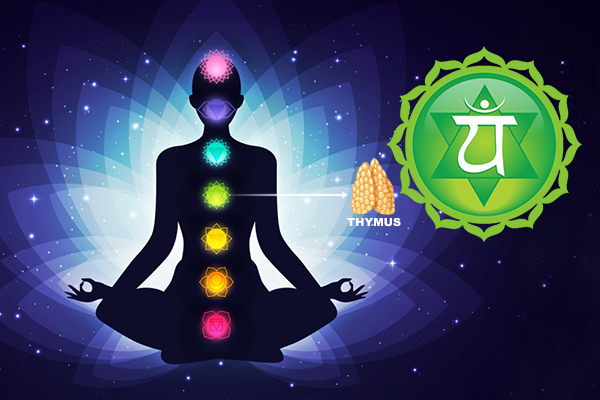
Anahata Chakra, or the Heart Chakra, is the fourth chakra after the Root Chakra, Heart Chakra, and Heart Chakra. The heart (Anahata) chakra is the connection point between the lower three chakras, which govern the tangible world defined by the body, mind and identity, and the upper three chakras, which define our spirit through will, intuition, and spirituality. Thus, Anahata is the last of the human chakras and connects the power of being human to a human being. It teaches you that you are a divine being in a human form. Consequently, you possess the ability to create like a god within the human realm. You turn energy into matter through this chakra. Anahata is all about choosing the higher emotions of freedom, compassion, generosity, forgiveness, and trust over the lower base emotional level of possessiveness, selfishness, revenge, and mistrust.
Your heart chakra awakens and realizes your ability to see love unconditionally, spread your light, and manifest loving relationships. Being in this frequency manifests your deepest desires and dreams. In essence, this chakra uncovers your qualities of unconditional love and light, which are becoming compassionate, empathetic, loving, forgiving, and a master at manifestation. When you use your heart center, you end up using all the senses life has to offer that enrich you. Your experience consciousness is in your heart chakra.
Anahata is all completely about choosing the higher emotions of freedom, compassion, generosity, forgiveness, letting go, faith, and victory over the lower base emotions such as possessiveness, selfishness, revenge, and mistrust. A balanced heart (Anahata) chakra makes you friendly and compassionate and helps in fostering harmonious relationships. If underactive, you will be cold and distant, and if overactive, you will be overbearing in the matter of love.
Location: At the end of the central sternum.
Color: Green
Beej Mantra: YAM
Primary Focus: Love
Right: To Love and be Loved
Organs: Heart, lower lungs, chest and circulatory system.
Endocrine Gland: Thymus
Sense: Touch
Element: Air
Anahata Chakra Meaning
Anahata is a Sanskrit term that means 'unstruck' or 'unbeaten.' It embodies a sound that emerges spontaneously, symbolizing a state of pristine consciousness. This energy center when aligned and in balance represents an inner resonance that surpasses the conflicts and disturbances of the physical world. It is a sound or vibration from the heart, symbolizing pure love and compassion. The Heart Chakra, Anahata, symbolizes a pure space where love flows freely, untouched by ego, past traumas, or external influences. Love transcends emotions and exists as a constant, unconditional, and pure state of being. It manifests as a harmonious and boundless energy that connects all life, transcending the physical.
The Anahata (Heart) Chakra is associated with the ability to desire and manifest outside of the realm of karma. The laws of karma bind the person in Anahata and below. In Anahata, one is manifesting, 'following your heart', based upon one's higher self and not just from unfulfilled emotions and desires of lower nature. Indeed, the Kalpavrishka, also known as the 'wish-fulfilling tree', resides here in the heart chakra, symbolizing the ability to manifest whatever you wish to happen in the world. It is associated with the emotional state of love, compassion, kindness, charity, giving, abundance and generosity.
Anahata Chakra Symbol
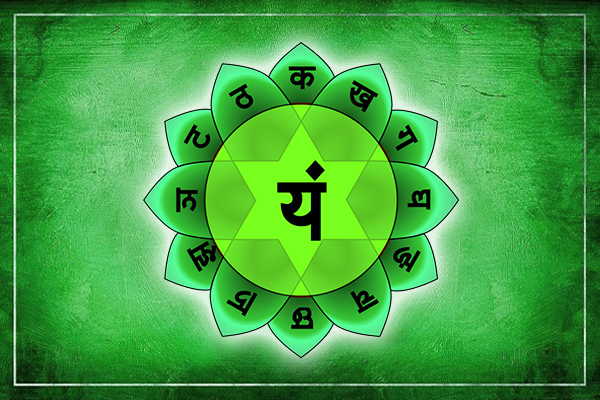
The Anahata Chakra symbol embodies deep spiritual concepts, including love, compassion, and emotional harmony. This design features a circle symbolizing unity and infinity, encircled by a twelve-petaled lotus. The petals display Sanskrit letters representing sound vibrations linked to qualities of the heart, such as peace, compassion, clarity, and kindness. The inscribed letters include Kam, Kham, Gam, Gham, Ngam, Cham, Chham, Jam, Jham, Nyam, Tam, and Tham. The vibrations form the core of the chakra's energy. The circle contains a six-pointed star, known as Shatkona, formed by interlocking triangles. The symbol represents the balance between Shiva, representing masculine energy and fire, and Shakti, representing feminine energy and water. The bija mantra 'Yam' resonates with the central air element. It captures the essence of love's boundless and fluid nature. The mentioned elements embody the core of the Anahata Chakra, deepening our understanding of love and compassion.
The symbol is characterized by a central circle, which represents the cyclical nature of existence, unity and wholeness. This circle, which serves as a reminder that love and compassion are boundless and extend infinitely in all directions, represents the interconnectedness of all life. It represents the eternal flow of energy within the heart, illustrating how love sustains the soul and connects us to the larger universe.
Anahata Chakra Deities & Planets

The Anahata chakra is linked to Bhagwan Vishnu and the planet Mercury. People revere Bhagwan Vishnu for his role as the protector and guardian of the universe. He embodies qualities such as harmony, compassion, and balance, which are closely associated with the Anahata Chakra that governs love, empathy, and emotional well-being, mirroring Vishnu's role in preserving and nourishing life.
Mercury is associated with communication, intelligence, and adaptability. It also impacts our ability to express love and maintain harmony in our relationships, both of which are associated with the Anahata (Heart) Chakra. Bhagwan Vishnu and Mercury are naturally aligned with the energy of the Anahata Chakra, promoting emotional balance, clear and compassionate communication, and a deep sense of universal love. These aspects are essential for maintaining inner peace and harmonious interactions with others.
Anahata Chakra Benefits
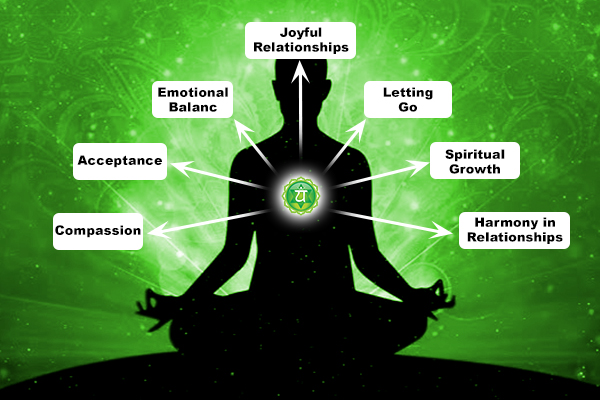
The Anahata Chakra connects our emotional and spiritual selves. When this chakra is open and balanced, love, compassion, and empathy flow together in harmony, allowing us to form deep connections. This chakra promotes self-acceptance and empathy for others. The release of past traumas and emotional wounds can result in deep peace and emotional freedom. This state promotes resilience, forgiveness, joy, and agreement. When the Anahata (Heart) Chakra is balanced, we can freely express and receive love in our relationships. This makes life more satisfying and purposeful.
The Heart Chakra plays an important role in heart, lung, and circulatory health. It promotes optimal heart and respiratory function, which is essential for overall health. When this chakra is in balance, life force energy flows freely, increasing physical vitality and resilience. Taking care of this chakra can reduce stress and anxiety, lower the risk of heart disease, and increase life expectancy.
Here are the benefits of a balanced Heart chakra:
- Compassion: The Anahata Chakra helps us embrace unconditional love. Kindness, empathy, and compassion are extended to both others and ourselves.
- Emotional Balance: This chakra helps achieve balance in emotions. It highlights the importance of finding a middle ground between love and boundaries, reciprocity, and staying grounded amidst emotional turmoil.
- Letting Go: Anahata promotes the practice of forgiveness to let go of feelings of sorrow and resentment. It emphasizes the significance of releasing past hurts to create room for healing and love.
- Acceptance: The heart chakra underscores the importance of self-acceptance and nurturing self-love. It encourages us to embrace our authentic selves, including our flaws and imperfections, with kindness and compassion.
- Harmony in Relationships: The Anahata Chakra is essential for maintaining healthy and harmonious relationships. It underlines the importance of communicating with love, and establishing connections based on mutual respect and understanding.
- Connection with Nature: Anahata has a deep bond with the natural world. It teaches us to appreciate the beauty of nature, recognizing the interdependence of living beings, and fostering a sense of environmental harmony.
- Spiritual Growth: The heart chakra serves as a doorway to elevated spiritual dimensions. It emphasizes the significance of embracing a compassionate mindset, rising above selfishness, and fostering a spiritual bond with both ourselves and those around us.
Spiritually speaking, the Anahata Chakra connects the self to universal consciousness. We transcend ourselves and embrace limitless love by discovering our deep connection to all living things. This chakra can help us connect with the infinite and develop compassion for all of creation, not just our immediate surroundings. Anahata's energy blurs the distinction between self and other, allowing for spiritual fulfillment and a better understanding of our purpose in the universe. The heart chakra symbolizes the center of our spiritual journey, where love directs our thoughts, actions, and relationships.
Core Lessons of Anahata Chakra
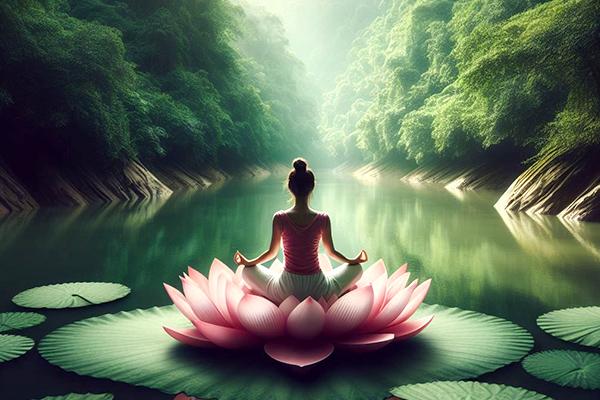
The people you have relationships with can have an impact on your Heart (Anahata) Chakra. We often have expectations in our relationships. When your expectations are not met, it can leave you feeling disappointed, sad, and disoriented, which can lead to hurt and grief. The teachings of Anahata chakra emphasize the importance of letting go of expectations and attachments to others. This allows us to embrace freedom, manifest our desires, and view all relationships as partnerships that serve our purpose on this earth. By letting go of these, the unions you have formed can become divine, allowing unconditional love to flourish. This will help you break free from negative karmic bonds and other unhealthy dependencies that are holding you back, enabling you to love and move forward.
Release Expectations
Understand that the heart chakra only comes into play with those with whom we form a union in some way. When we create these connections, we often anticipate outcomes that align with our expectations. You need to realize that no one can happen your way, and moreover, no one must happen your way. It's a mistake to assume that others should behave and behave in a way that aligns with your expectations. Once you accept that your way of discerning is not the only right way, you will find it easier to reject the assumption, adjust, or even completely drop your expectations. Try putting yourself in the other person's or your company's shoes to understand why they are behaving a certain way. Understand that every person has his own limitations, thinking, behavior, weaknesses, and strengths, and they will evolve in their own time. Therefore, acceptance and adopting a non-judgmental attitude are key to finding peace rather than forcing others to be and happen the way they are not.
Let go of attachments
Experience each moment for what it is, and accept it without relating it to past or future moments. No moment can repeat itself or last forever, because nothing is permanent. Fighting this reality will only cause you pain. Your relationships with people in your life might be based on a particular “need” for security, safety, joy or pleasure, and self-worth. Nevertheless, contemplate that even new things, situations, and people may give you the same feelings. Therefore, you should always remember to let go of past attachments and open your heart to new possibilities, as this process has been ongoing since your childhood and will persist whether you actively seek it or not.
Remember, nothing is 'yours,” but it pertains to the universe to which you are playing part of it. Let go of the importance of bonding, understanding that everything is part of the same universal web, no one is alone, and attachment is merely a mental construct. You have the power to opt from moment to moment how you experience events: with a sense of possession, anxiety, and fear; or with a sense of freedom, peace, and love.
Open to Trust
If you've suffered damage to your trust, you might think it's impossible to trust again. But don't attempt to protect yourself by being distrustful; all you're doing is erecting a barrier between yourself and others. And this is a prescription for a lonely, dissatisfied existence devoid of meaningful interactions. You can overcome the anguish of shattered trust. Notwithstanding, you can learn how to trust again. When you were little, you used to naturally trust everyone around you. These individuals, upon whom you placed your trust, may not have been flawless, or they may have even instilled in you a sense of distrust. Try to erase and rewind to that early naive state of mind and be receptive again to what life has to offer to you, be it things, situations, or relationships.
Forgiveness
To blunder is human, and to forgive is divine. As you go through the tough lessons in life, you will inevitably encounter situations that demand you forgive those who hurt you, made you feel less, caused you any agony and misery, or left you in a relationship. You cannot be living with pain and carrying this kind of baggage for long. Release pain and forgive those who have hurt you intentionally or non-intentionally, as this will set you free. Forgive is not the same as forget. It doesn’t mean you must forget and erase from your memory what happened; it just means you don’t feel stuck on that event from the past anymore, so that you can love and move ahead freely.
Forgiving requires us to let go of our anger; of our want to punish and teach a lesson; of our want to harm our harmer; of the want for an apology; and of the want for our harmer to change. When we are unable to forgive, our hearts are filled with pain. We close our hearts, preventing any positive emotions or good people from entering our lives. We gradually begin to lose our ability to love and receive love from others.
Surrender
For the majority of our lives, our upbringing instilled in us the belief that we can achieve anything we set our minds to. Everything around us has conditioned us to believe we are in control. Surrender is the act of dispelling the illusion that we are in control, and it is the deliberate decision to give up this misconception.
Surrender may conjure images of giving up, resigning, or throwing up the towel when it’s not understood correctly. Surrendering to the ultimate reality entails accepting the truth in all of its manifestations. We no longer battle against the way things are but instead are open to the experience of the self. When we are free of expectations and the desire for things to be one way or another, the walls between dualities begin to collapse, and we connect with the divine. When we fully surrender to ultimate truth and the way these things are, we begin to transcend separateness. This surrender, devotion, or acceptance frees us from depending on the ego and the thinking mind to complete our task and enables us to connect with something more profound within us. The subtle body's intuition, the divine within us, moves us instead.
The ego takes action. Surrender does nothing. The ego is the doer who works through separation. It is externally oriented and seeks reward in the form of praise, recognition, or success, as well as the acquisition of goods. On the contrary, surrender means letting go, ceding to experience, taking a step back, observing, and going with the flow. Surrender signifies complete atonement to our higher self through a state of equanimity.
Balanced & Imbalanced Anahata Chakra
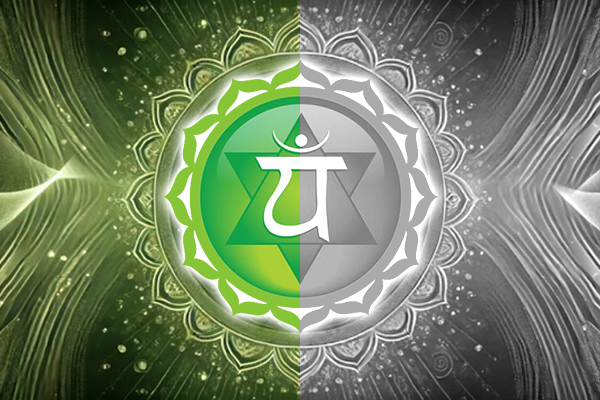
A person with a balanced Anahata (heart) chakra is able to effortlessly create—manifest what they truly desire (and deserve) in life. They enjoy comfortable, loving, and empathic relationships at home, at work, and in their community, feeling a beautiful and deep connection with others. They display candidness, spontaneity, big-heartedness, and trust.
A person with a balanced heart (Anahata) chakra is capable of true compassion and unconditional love. There is a healthy level of self-acceptance and compassion for oneself as well as for others. This person also desires a spiritual experience in all his actions.
The physical manifestation of a healthy Anahata chakra is a good immune system. On the other hand, an imbalanced heart chakra causes fear, hatred, expectations, and depression. It also leads to mistrust and control in relationships.
Imbalanced Anahata Chakra
A person who has an imbalanced Anahata (Heart) Chakra will obstruct everything good that comes their way. They are prone to sabotaging their relationships and careers through distrust, anger, and vengeance. They are sad and have a sense of being neglected, rejected, and overly emotional. They may become overly possessive and act like doormats for those they love, or they may be afraid of losing their independence or control over others if they rely on them. They have doubts, suspicions, and a conflict between their heart and mind.
When the heart chakra is blocked, it prevents love from being allowed in, which results in a lack of self-love and feelings of unworthiness and self-pity. Out of fear of rejection come attitudes of loving too much or unrealistic expectations from others, like being the knight in brilliant armor or bringing the moon, etc. We often find attitudes of self-righteousness, blaming the other person, being critical of others, judgmental, and dwelling on the failures of past relationships. Emotional states include being unforgiving, still being stuck in anger at past betrayal, fear of intimacy, loneliness, depression, and grief.
Overactive Anahata Chakra
When your Anahata Chakra is overactive, you lack discernment in your relationships and get controlled by emotions. You feel too emotional and display extremes in pleasure, pain, love, grief, anger, and possessiveness. You will be in relationships where you are always giving but not receiving. You may not be able to let go of relationships that have gone past their expiry dates.
When the Heart (Anahata) Chakra spins too fast or is too open, it can lead to distorted forms of loving relationships, specifically conditional love. Manipulative behavior, such as emotional withholding to 'punish' or overly dramatic behavior in relationships, may also manifest. Co-dependency, jealousy, and needy cravings for connection will also be present, as will an inability to establish healthy boundaries or a failure to recognize when a relationship is abusive.
Underactive Anahata Chakra
Someone with an underactive Anahata may appear distant and aloof. In this low chakra mode, there is an overall lack of sense of compassion towards others and one selves. You may still feel bitterness, sorrow, and grief from unresolved emotional wounds. You may be judgmental, critical, skeptical, and intolerant due to your distrust of others. Fear of rejection can lead to excessive love or unrealistic expectations, such as trying to be a knight in shining armor or bring the moon. Self-righteousness, blame, criticism, judgment, and fixation on past relationship failures are common. You may feel unforgiveness, anger from past betrayals, fear of intimacy, loneliness, hopelessness, and grief. You're shy because you're afraid of being hurt or rejected, making it hard to be yourself. You may become clingy and needy in relationships, focusing on your emotional needs rather than unconditional love and acceptance.
Signs that your Anahata Chakra is Imbalanced
An imbalanced Anahata Chakra leads to feelings of loneliness, jealousy, and possessiveness. It can be difficult to forgive, hold grudges, and remain bitter. Heart and lung issues, mood swings, and the inability to form healthy relationships are all common. Compassion, empathy, and inner peace can be difficult to achieve when spirituality is unbalanced and disconnected from nature.
Physical
- Heart Diseases
- Allergies
- Fever
- Asthma
- Sneeze
- Hay Fever
- Cholesterol
- Triglycerides
- Lung Ailments
Psychological
Underactive Anahata Chakra:
- Struggling to forgive oneself or others, or holding grudges or resentments.
- Difficulty understanding and empathizing with the emotions of others.
- Having trouble forming close relationships.
-
Low self-esteem, self-criticism, or a failure to fully accept and love oneself.
Overreliance on others, or constantly seeking approval from others. - Emotional numbness, loneliness, or depression that persists.
Overactive Anahata Chakra:
- Becoming more sensitive.
- Excessive insecurity, possessiveness, or jealousy in a relationship.
- Emotional numbness, loneliness, or depression that persists.
- Self-sabotage in relationships can stem from a deep fear of rejection.
Career & Social
Underactive Anahata Chakra:
- Disconnection from work makes achieving career goals difficult.
- Fear of criticism or rejection may keep you from seizing opportunities.
- Trouble making or keeping friends, often feeling emotionally distant.
- Mistrust that leads to isolation or inability to rely on friends and family.
Overactive Anahata Chakra:
- Workplace issues such as being uncooperative or unable to build trust may arise.
- Overworking may help you avoid emotional problems or feelings of inadequacy.
- Insecurity and fear of loss due to possessiveness in relationships.
- Conflicts, misunderstandings, and strained relationships.
- Feeling jealous, possessive, or insecure in relationships.
Spiritual
- Feeling lonely, isolated, or unable to form meaningful relationships.
- Inability to empathize, resulting in coldness, apathy, or harsh judgments.
- Disconnection from the higher self, which leads to spiritual dissatisfaction.
How to balance Anahata Chakra?
Chakra balance is best achieved when we align to the lessons of the chakra and start to actively apply these lessons in our daily lives. Other methods include breathing exercises, mantra chanting, meditation and visualization techniques, aromatherapy and sound therapy, energy healing techniques like reiki, yoga practice, diet (foods and drinks) adjustment, and the use of Rudraksha and gemstones.
Align to the Lessons of Anahata Chakra
Practice unconditional love and compassion by opening your heart to others without any expectations. Nurture self-love and acceptance by embracing your authentic self, including your imperfections. Establish healthy boundaries and practice equitable giving and receiving of love to achieve emotional balance. Embrace forgiveness and let go of past hurts and resentments to facilitate healing. Deepen your bond with nature and the world, acknowledging the interconnectedness of all living beings. In order to nurture your spiritual growth, it is important to transcend ego, embrace vulnerability, and connect with the divine essence within yourself and others.
Personal One-on-One Counseling
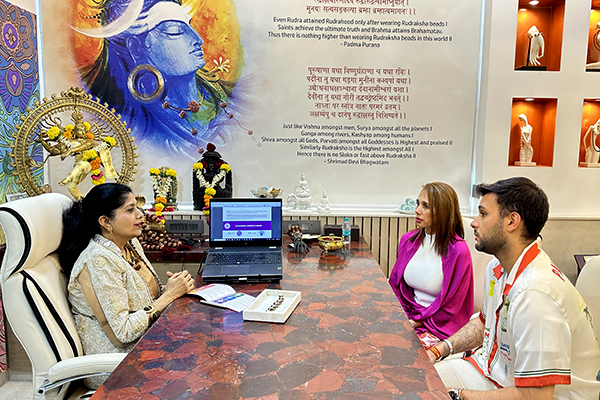
One-on-one Rudraksha Ratna Chakra Therapy (RRCT) counseling sessions combine the ancient knowledge of rudraksha beads and gemstones with a deep understanding of energy science and human psychology. This is done by carefully identifying and reflecting on the root cause of the chakra imbalance, rather than the external symptoms. RRCT counseling identifies subconscious patterns deeply ingrained in our behavior, such as fears, old habits, experiences, beliefs, and other factors that are restricting our energy centers and limiting our lives by causing these vital energy centers to malfunction. The counselor then tailors specific rudraksha combinations and gemstones to your unique needs, which you wear on your body to facilitate continuous energy alignment. This comprehensive method not only promotes physical and emotional well-being but also supports spiritual growth, leading to a more balanced, fulfilled, and empowered life.
Wear Rudraksha & Gems as per RRCT
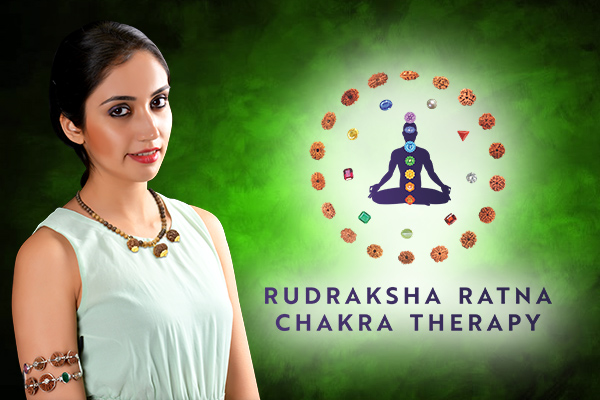
According to Rudraksha Ratna Science Therapy (RRCT), you wear specific combinations of sacred Rudrakshas and Vedic gemstones that give your Heart (Anahata) chakra the necessary frequency and color to balance it. Rudraksha beads and gemstones help balance the chakras by emitting resonance frequencies that align with the energy centers. Each rudraksha bead and gemstone is connected to specific chakras, seamlessly balancing the energy flow in these centers. When worn, they positively impact imbalanced chakras, gradually clearing disruptions and restoring harmony. RRCT is highly effective because it carefully matches rudraksha and gemstone combinations to each individual's specific energetic needs. This ensures a focused approach to chakra healing and personal growth.
Yoga, Mantra & Mudra Meditation
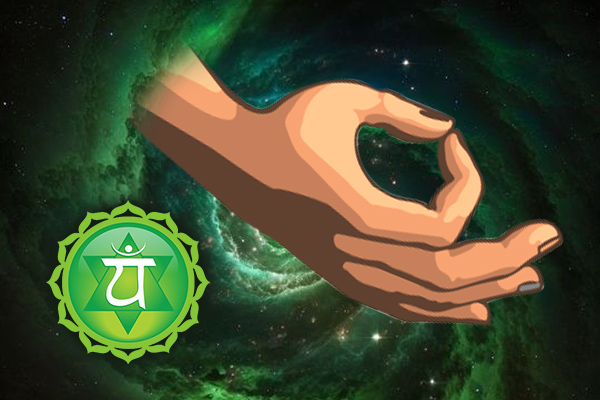
Yoga poses are especially helpful in balancing and opening the Anahata Chakra (Heart Chakra), such as Ustrasana and Bhujangasana that open the chest, and promote emotional release. Matsyasana and Anahatasana encourage a sense of connection. Setu Bandhasana and Garudasana stretches the upper back and shoulders, encouraging balance in giving and receiving love. These poses help to release emotional blockages, foster compassion, and energize the Anahata Chakra, resulting in a balanced and loving state of being.
Mantras are effective tools for enhancing mental focus and promoting chakra balance. Here are various mantras associated to the Anahata Chakra:
Beej Mantra
'Yam' (यम्): Chanting 'Yam' helps to balance the Heart Chakra.
Vedic Mantra
'Om Yat Sat Tat Savitur Varenyam Bhargo Devasya Dhimahi Dhiyo Yo Nah Prachodayat' (ॐ यत् सत् तत् सवितुर् वरेण्यम् भर्गो देवस्य धीमहि धियो यो नः प्रचोदयात्)
Bhagwan Vishnu Mantra:
'Om Namo Bhagavate Vasudevaya' (ॐ नमो भगवते वासुदेवाय)
Mercury (Budh) Mantra:
'Om Budhaya Namah' (ॐ बुधाय नमः)
Mudras (hand gestures) assist in channeling energy flow within the body. The Hidraya Mudra is highly effective in balancing the Anahata Chakra.
Here is how to perform Hidraya Mudra Meditation:
Find a comfortable position to sit with a straight spine, either in Sukhasana (Easy Pose) or on a chair, and relax your shoulders.
Position your hands on your knees or thighs, palms facing upward. Place your index finger against the base of your thumb, and bring the tips of your middle and ring fingers to touch the tip of your thumb. Keep your little finger extended.
Direct your focus towards the area in the middle of your chest, known as the heart center. As you do so, inhale deeply and exhale slowly, allowing your breath to flow calmly. Experience the expansion of your chest with every inhale and the relaxation with every exhale.
Keep the Hridaya Mudra for 5 to 15 minutes, letting the energy to flow into your heart chakra, encouraging love, compassion, and balance in your emotions.
Other mudras for the Anahata chakra are Anjali Mudra, Gyan Mudra and Padma Mudra.
Chakra Vedic Mantra
Anahata Chakra Yantra
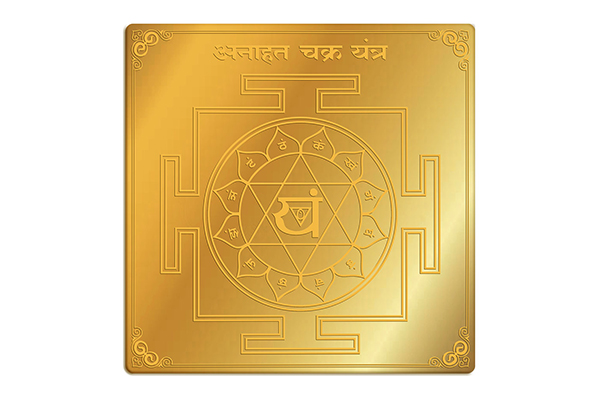
The Anahata Chakra Yantra creates a friendly and kindhearted atmosphere wherever it is placed. Negative emotions such as anger, distrust, grief, or suspicion wind out, leaving a more breathable and calmer environment. The energy within this yantra renews personal relationships and the ability to forgive and let go, as well as making them more compassionate and generous. It opens the gateway to the higher consciousness of the heart. The person elevates from worldly attachments and can focus on knowledge, creation, and spiritual growth. The Anahata Chakra Yantra is the most powerful yantra to fulfill our heartfelt desires and attracts auspicious relationships, prosperity, and fulfillment.
Anahata Chakra Puja
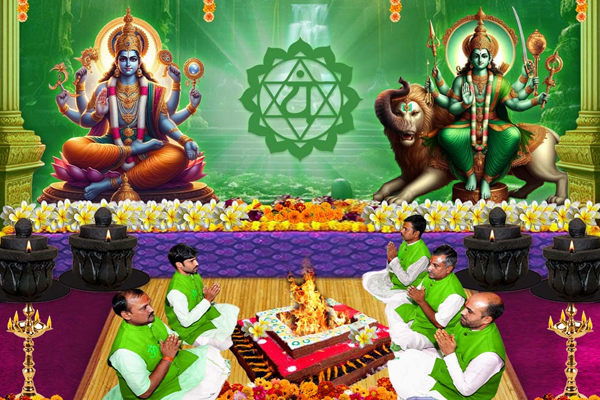
The main deity of Anahata Chakra Puja and Mantra Japa is Bhagwan Rudra, and the ruling planet is Buddh or Mercury. Bhagwan Rudra is a fierce form of Bhagwan Shiva, associated with storms; His arrows hit like lightning, and He is also known as a master healer, a celestial physician who has the medicine for every imaginable disease or ailment. The Anahata Chakra Balancing Puja and Mantra Japa are done to balance the Anahata Chakra for harmonious relationships with one’s own self and others. Blockages and imbalances in the Anahata Chakra lead to negative emotions and feelings such as hatred, fear, jealousy, depression, unhappiness, disharmony in relationships, bitterness, and anger. The Heart Chakra can be effectively cleared and balanced by performing the meritorious Heart Anahata Chakra Puja for healing discord or unhappy relationships.
Color Therapy
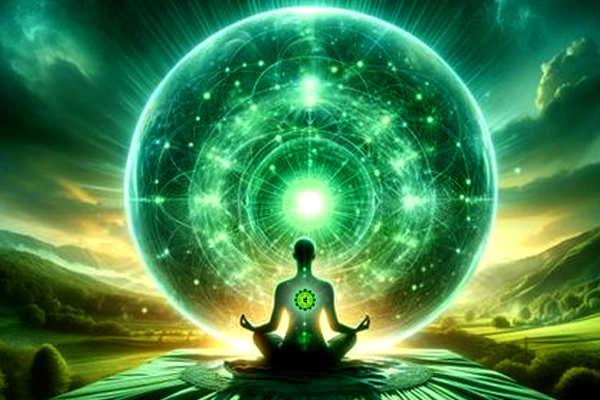
Balance the Anahata Chakra by including the calming green hue into your daily life in several ways. Surround yourself with green items including décor, clothes, or plants releasing the healing power of the heart chakra. Engage in activities in green areas, such nature walks or gardening, to fully appreciate the peaceful and energizing aspects of the color. See a brilliant green light radiating from your heart center spreading and encircling your whole being during meditation. Harmonizing and energizing the Anahata Chakra helps this practice foster emotional balance, love, and compassion.
Belief Clearing, Reiki & Positive Affirmations

Belief clearing, Reiki, and positive affirmations can balance the Heart Chakra (Anahata). Release restrictive beliefs through belief clearing. Replace these beliefs with empowering, positive ideas. Reiki purifies and balances the Heart Chakra. It channels life force energy to boost physical and emotional health. Regular positive affirmations can help balance your Anahata chakra. These practices remove blockages and establish a healthy and spiritual foundation.
Affirmations:
- I deeply and truly love and approve of myself.
- I am adequate at all times to do that which is required of me.
- I am willing to love everything about myself.
- I trust in love.
- I open my heart to love.
- I forgive myself.
- I forgive those who need forgiveness for not meeting my expectations.
- I acknowledge my own loveliness.
- I am pure, good, and innocent.
- Love is the purpose of my life.
- Love is everywhere.
- I open myself to the healing powers of love.
- I follow the path of the heart.
Crystal Therapy
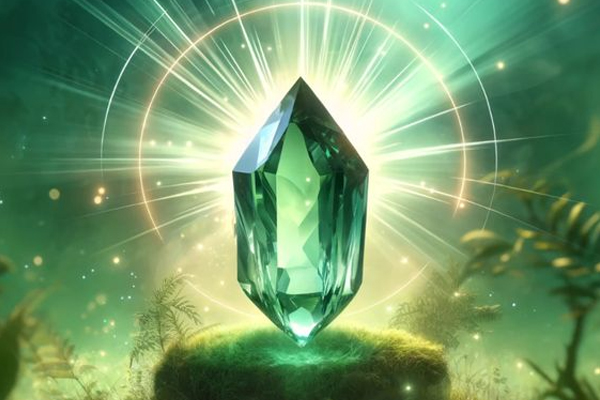
The best crystals for Anahata are usually those with the same color hue as Anahata - envisage green colors from light to dark hues and also some yellow and pink colors too.
Emerald activates and balances the Heart (Anahata) Chakra. Stunning and vivid green Emeralds aligns the wearer with their inner desires and wisdom, making you feel comfortable in relationships, able to give and receive love quickly, without any expectations.
Green Jade eliminate bad energy, allowing better and uplifting energies to flow. It will also counteract any negative karmic impact as well as any unhealthy emotional difficulties that may arise as a result of them.
Green Aventurine is a crystal of power, confidence, bravery, and happiness. It restores one's faith in life and motivates us to take action in order to get what we want in this world.
Green Calcite is an ideal stone for relieving unwanted everyday tension and calming any pent-up energy that may have accumulated over the day.
Green Moldavite is also known as 'The Holy Grail Stone' or 'The Stone of Transformation' because these natural green crystals are powerful to generate transformation, good luck and desires fulfillment.
Amazonite excels in calming nervous dispositions and self-destructive ideas. It's also a fantastic stone to have on hand when you need to pick yourself up by the bootstraps.
Peridot is a valued gemstone recognized for its summer energy, good luck vibes, and remarkable ability to keep you calm and feeling secure no matter what is going on around you.
Conclusion
In conclusion, when your Heart (Anahata) Chakra is balanced, prana, or life force energy, can freely flow through all aspects of your life associated with love, compassion, and emotional health. When this chakra is balanced, you are naturally compassionate and giving, effortlessly manifesting your deepest desires and living a life that reflects who you are. Your relationships are defined by a deep spiritual connection, which leads to incredibly satisfying and genuine feelings of intimacy and love with your partner. Your emotional stability and inner serenity reflect this. You display an altruistic and empathetic nature and you are a master manifesting your true dreams. You have a pure spiritual experience in your relationships and in lovemaking with your partner. You are at ease with your body, have a healthy body and a good quality lifestyle.

-in-Astrology.jpg)

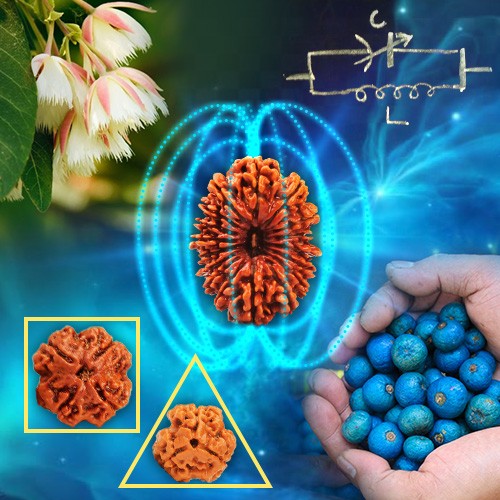



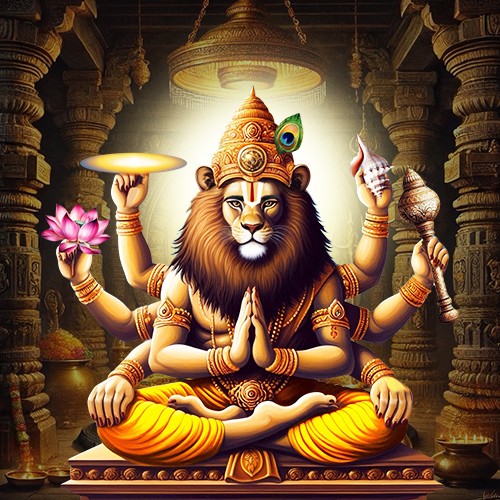
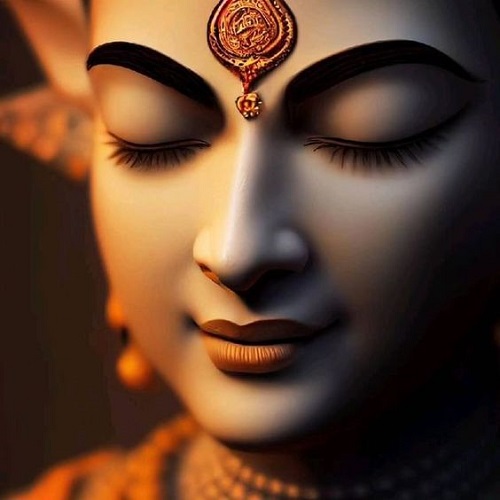
.jpg)
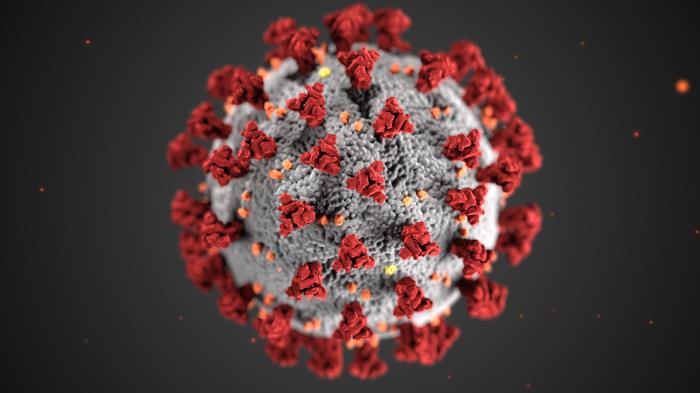
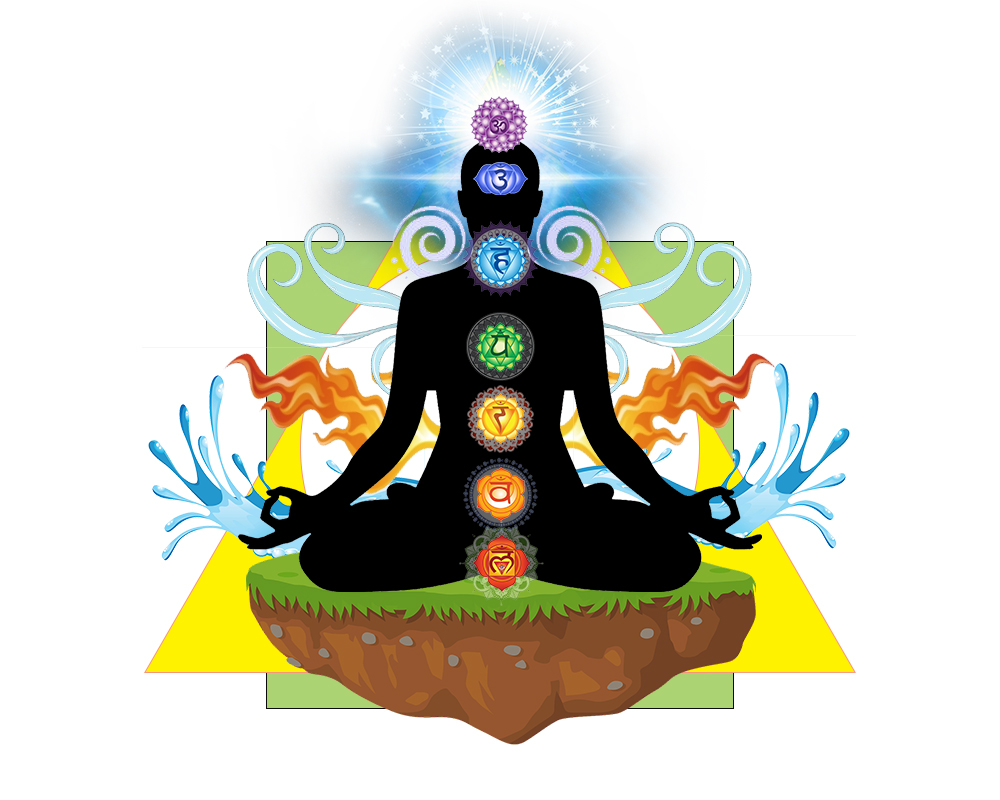
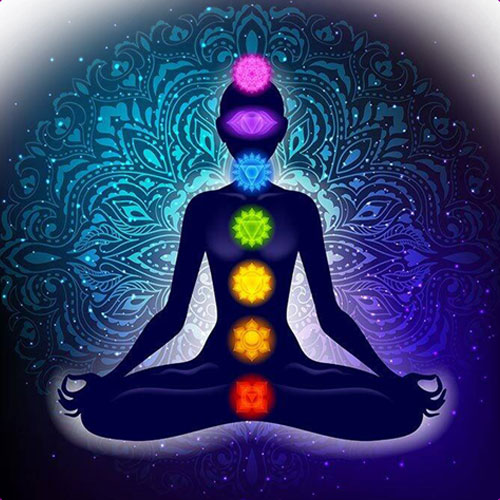
Comments 0
Leave your thought here